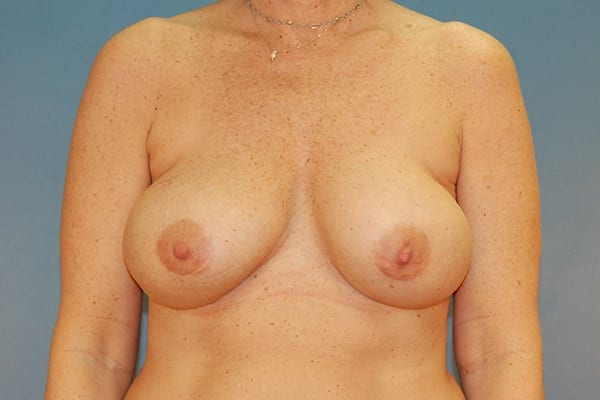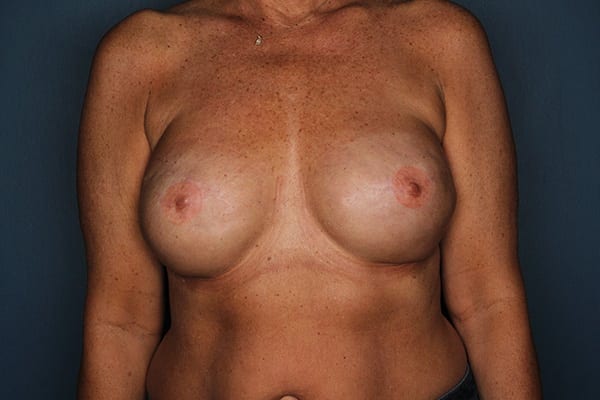Breast Reconstruction
Surgery in Birmingham, AL
Schedule A Consultation
Breast Reconstruction Surgery
It is estimated that over 287,850 women will be diagnosed with breast cancer this year. Many of those diagnoses will result in a mastectomy. Although the diagnosis can be overwhelming, breast reconstruction allows a patient the opportunity to feel whole again, emotionally and physically. Many breast cancer survivors report that reconstruction allowed them to move beyond their cancer diagnosis both physically and mentally.
Breast reconstruction surgery restores a more normal breast appearance to women who have lost a breast to cancer or injury. Reconstruction is achieved through a variety of plastic surgery techniques designed to recreate the breast. Breast reconstruction is often completed in stages. A majority of women opt to begin reconstruction at the time of their mastectomy (immediate), but there are times when reconstruction is delayed based on the needs or desires of the patient.
What Are the Benefits of Breast Reconstruction Surgery?

Restored Breast Appearance
Following mastectomy on one or both breasts, many women struggle with their appearance. Breast reconstruction allows women to restore their feminine curves by recreating a natural breast aesthetic. Various treatment options are available to reconstruct the form of the breast. These include using implants or natural tissue.

Breast Symmetry
For women who underwent a mastectomy on one breast, breast reconstruction will restore shape and volume to the breast to complement the unaffected breast. Breast enhancement surgeries can be performed on one or both breasts to regain symmetry. While some asymmetry may be present, it should not be noticeable.

Emotional and Physical Wholeness
Reconstruction helps return the patient to a pre-mastectomy appearance. This restoration allows the opportunity to regain self-confidence and body confidence. Many of our patients report that seeing their physical body with restored breasts allows them to move past a cancer diagnosis and on to emotional well-being.
What Are My Breast Reconstruction Options?
Dr. Cohn will tailor your breast reconstruction plan based on your needs and specifications. Most reconstruction candidates will receive recommendations for multiple options.
Nipple sparing implant reconstruction uses tissue expanders and silicone/gel implants to recreate the breast mound without removing the nipple.
Nipple sparing implant reconstruction is performed in two stages. The first stage can begin at the time of your mastectomy. A tissue expander is placed in the breast pocket where your natural tissue was located. This procedure usually takes approximately three hours, which includes the mastectomy.
Expansion takes place over a series of follow-up appointments. The size of the tissue expander increases gradually, stretching the skin in preparation for the final implant.
The second stage of this process involves removing the expander and replacing it with a permanent silicone implant. You and the doctor will work together to determine the size of the implant. Fat grafting may be used in combination to enhance the breasts’ natural appearance. The second stage of this process is performed as an out-patient procedure and usually takes between an hour and a half and two hours to complete.
Insurance requires at least a 90-day waiting period between the surgery stages.
Dr. Cohn and your oncologist will determine if you are a candidate for nipple sparing implant reconstruction. This will depend on your tumor characteristics and pre-op MRI.

Non-nipple sparing implant reconstruction uses tissue expanders and silicone/gel implants to recreate the breast after a complete mastectomy, including the removal of the nipple-areola complex.
This procedure is very similar (and performed in the same way) to nipple sparing implant reconstruction; however, the nipple is also removed during the mastectomy.
This technique is also performed in two stages: the first to insert the tissue expander, and the second the replace that expander with the final implant.
Nipple tattooing is optional following the second stage of this surgery. Insurance usually requires a 90-day waiting period after the second stage before nipple tattooing can occur.
Non-nipple sparing implant reconstruction using tissue expanders is ideal for women who are unlikely to go through radiation. This procedure may also be a good choice for patients that cannot tolerate a lengthy procedure due to health concerns.

Non-nipple sparing latissimus flap reconstruction with tissue expanders uses tissue taken from your back to recreate the breast mound.
Like non-nipple sparing implant reconstruction, this option also requires the use of a tissue expander.
With this technique, Dr. Cohn harvests tissue from the latissimus muscle found in the center of your back. This tissue is tunneled under your arm to the breast area, creating a pocket for the tissue expander to be placed beneath. This process takes approximately five to six hours, which includes the mastectomy.
Once the expansion is complete, the expander is removed, and a permanent silicone implant is added.
Nipple reconstruction and additional fat grafting can be performed following the second stage to increase the natural look of the breast.
Nipple tattooing can occur once the breast appearance has stabilized. Insurance requires at least a 90-day waiting period between the second stage and the nipple tattooing.
The latissimus flap with tissue expander technique is ideal for women with larger breasts who are still anticipating chemotherapy or radiation treatments. Those with additional health concerns, such as diabetics, smokers, and women who have complications healing, also benefit from this technique.

Non-nipple sparing TRAM flap uses tissue from the transverse rectus abdominis myocutaneous (TRAM) to recreate the breast mound without using an implant.
The TRAM flap technique utilizes tissue and blood supply from the lower abdomen to reconstruct the breast. This technique takes approximately six to eight hours to complete, which includes the mastectomy.
This technique is only appropriate for women with no prior abdominal surgery and enough abdominal tissue to recreate one or both breasts. Women who are not candidates for implant reconstruction or those with failed implant reconstruction may consider TRAM flap surgery.
This technique may not be an option for some patients due to an increased risk of abdominal hernias, bulges, or changes in core strength.

Concerns
Consultation
What Is Discussed During My Breast Reduction Consultation?
Your consultation is an essential part of your breast reconstruction process, and the success of your surgery relies on your openness and truthfulness during this discussion.
Dr. Cohn will evaluate your medical history, discuss your interest in breast reconstruction, explain how the different techniques work, and suggest an appropriate plan for you.
You will be given detailed instructions regarding how to prepare before the surgery and how to take care of yourself after the surgery.
Dr. Cohn will see you on the day of your surgery to mark the surgery areas and review any last-minute details with you. You will have an opportunity to ask him any remaining questions you have at this time.
Recovery
After you are released from the hospital, you will be required to have a responsible adult stay with you for up to a week to help with all necessary activities (changing, cooking, cleaning, driving).
Your breasts will be wrapped in a surgical bra that you will be required to wear for several weeks. We recommend wearing gowns or pajamas that button or zip in the front. This will prevent you from needing to lift your arms over your head. Traditionally, you should refrain from raising your arms for at least one week.
We suggest that all patients rest and sleep in a propped-up position. Recliner chairs and beds are ideal for this. You will not want to lay flat or on your side until you are cleared by Dr. Cohn.
Dr. Cohn will provide you with post-operative instructions that will detail when you can resume all activities. Most patients take at least four to six weeks off work and their normal, strenuous activities.
Most breast reconstruction patients require drains for about two weeks to prevent fluid accumulation; however, the longevity will depend on daily fluid output. You are required to keep a log of your drain output and bring this log with you to all appointments.
While the need for drains varies, most patients can expect:
- Two drains (one of each side in the mastectomy pocket) for nipple sparing and non-nipple sparing breast reconstruction.
- Four drains (two in the mastectomy pocket and two in the back) for latissimus flap reconstruction.
- Four drains (one in each mastectomy pocket and two in the abdomen) for TRAM reconstruction.
Scars
Will I Have Scars After Breast Reconstruction?
Scars will develop along the incision lines but will fade with time. To help minimize the visibility of the scars, avoid any excessive force, abrasion, or motion during the healing process.
Pain
Is Breast Reconstruction Painful?
Breast reconstruction is performed under general anesthesia and prescription pain medicine will be prescribed afterward to reduce any post-operative pain.
FAQs About Breast Reconstruction Surgery
Am I a candidate for breast reconstruction surgery?
Candidates for breast reconstruction are women who have undergone or are planning to undergo a mastectomy on one or both breasts and who can cope well with their diagnosis and treatment. Breast reconstruction should only be performed on women who have completed their cancer treatment and who have a positive outlook, realistic goals, and no health conditions that would impair their ability to heal.
We work directly with Blue Cross and Blue Shield (BCBS) of Alabama to determine pre-certification and policy requirements.
If I only had a mastectomy on one side, will I need breast surgery on both breasts?
In cases where only one of the breasts was affected, the unaffected breast does not need breast surgery. However, many women choose to undergo breast enhancement, such as breast augmentation, breast reduction surgery, or breast lift surgery, to improve symmetry of the breasts.
Will insurance cover breast reconstruction?
Breast reconstruction is required to be covered by insurance—at least in part—thanks to the Women’s Health and Cancer Rights Act (WHCRA). We accept Blue Cross and Blue Shield of Alabama. Because each policy is different, the extent of your coverage and your out-of-pocket costs will depend on your policy.
How should I prepare for breast reconstruction surgery?
Before your breast reconstruction, you will need to undergo testing and blood work. Dr. Cohn will inform you of all required testing during your consultation. Once your surgery is scheduled, you will be mailed a pre-operative packet that will describe any preparations or prescriptions that need to be filled beforehand.
In preparing for your breast reconstruction, you are allowed to take a multivitamin. We offer vitamins designed to help in the healing process for purchase in our office.
Where will my breast reconstruction surgery be performed?
Dr. Cohn has clearance to operate at most community hospitals and will work alongside your oncologist/general surgeon in planning your mastectomy/breast reconstruction journey.
When will my breast reconstruction be performed?
Breast reconstruction can be performed at the time of your mastectomy (immediate reconstruction) or months or years after you have healed (delayed reconstruction). While neither timeframe is considered better than the other, not all women qualify for immediate reconstruction because of additional cancer treatments. It is not recommended to have reconstruction if you are still planning to undergo chemotherapy or radiation.
Does breast reconstruction require an overnight stay at the hospital?
Yes, you will be required to spend at least one night in the hospital following your breast reconstruction. The exact amount of time will depend on the breast reconstruction technique you undergo.
Traditionally, you can expect:
- One night/two days for nipple and non-nipple sparing implant reconstruction
- Two nights/three days for the Latissimus flap with tissue expanders
- Four nights/five days for the TRAM flap
If my breast reconstruction included expanders, when will my expansion start?
If your breast reconstruction is being performed with the aid of expanders, you will usually have to wait around four weeks before the expansion will begin. While these expanders are placed during your initial surgery, you must wait until after all drains are removed.
Most insurance companies require a 90-day waiting period before the expansion is completed, and the final implants are placed.
Additional Frequently Asked Questions About Breast Reconstruction
-
Dr. Cohn will schedule a follow-up appointment two weeks after your surgery to ensure that you are recovering well and are not experiencing any complications.
-
You will be required to postpone showering until the morning following your breast reconstruction surgery.
-
Your skin will be numb following the surgery, and you may not be able to tell how the change in temperature is affecting you. DO NOT use a heating pad following surgery.
You may apply ice in moderation and only if there is a barrier between the ice and your skin.
-
While you cannot overstress your body after your breast reconstruction, we do suggest getting on your feet as soon as possible. During the first week, we recommend walking inside your house to promote circulation. During the second week, you can increase this to include more aggressive walks outdoors. We suggest waiting at least four weeks before attempting more vigorous activity, and you must avoid any bouncing for at least four to six weeks.
-
You will be asked to refrain from driving or operating any machinery for at least two weeks, or longer, if you are still on any pain medication. Before returning to the road, you need to be sure that you can react properly to road hazards and feel comfortable turning your body in all directions.
-
Before your breast reconstruction, we suggest stocking up on sanitary napkins, lanyards, and pillows. While the use of these items may not initially be clear, they can help promote ease and comfort during your recovery. Sanitary napkins help “pad” incisions and drain sites. Lanyards can be used to help hold drains in place. Extra pillows help ensure that you are comfortable at all times and help to prop your body up while sitting or sleeping.
-
Dr. Cohn offers two options for nipple-areola tattooing following non-nipple sparing breast reconstruction. If your insurance is covering the expense of this procedure, our aesthetician will perform nipple tattooing in our office. If you choose not to go with your insurance, we offer the tattoo services of Vinnie Myers from the Vinnie Myers’ Team.
Nipple tattooing requires one to two visits and is usually completed in one-hour sessions.
Blue Cross and Blue Shield of Alabama requires that you wait at least 90 days after your breast reconstruction to undergo nipple tattooing.
-
While they are rare, potential side effects and complications after breast reconstruction include:
- Problems with the anesthesia
- Bleeding
- Infection
- Blood clots
- Fluid build-up
- Prolonged wound healing
Fat necrosis - Loss of muscle strength at the donor site (for flap reconstruction patients)
- Implant complications (such as capsular contracture or implant rupture)
-
The results of your breast reconstruction will be long lasting if not permanent. If you undergo breast reconstruction with implants, you will need to monitor your implants and verify their integrity every few years with MRIs or ultrasounds on the breast (this is in addition to your routine mammograms). These tests will verify that silicone implants have not ruptured. We recommend getting the first scan three years after your breast reconstruction with implants and every two years after that.









